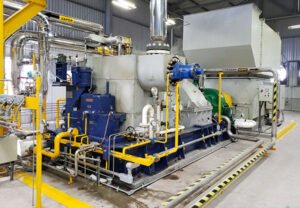How Do Steam Turbines Work?
Nuclear and coal-based thermal power plants together produce almost half of the world’s electric power, and steam turbines are the heart of these turbines in power plants. Steam turbines convert thermal energy into useful mechanical energy, which in turn rotates the steam turbine’s electric generator shafts to produce electricity. Charles Parsons first invented the modern steam turbine in 1884.
How Do Steam Turbines Produce Electricity?

A steam turbine and generator are made up of a series of stationary and spinning airfoil-shaped blades. The airfoil form of the blade creates a pressure difference as high-pressure steam travels over it. The pressure differential produces a lifting force, which causes the turbine to rotate. Thus, the conversion of energy takes place, which is from heat energy to mechanical energy to rotational energy. The rotation of the shaft drives the turbine that is connected to the generator. This is the basic how-to-work turbine principle, and the turbine manufacturers rely on it for the best turbine design.
How Does a Steam Turbine Work?
As the name implies, it is powered by steam. High-energy steam is injected into the turbine, which transforms the potential energy of the steam into kinetic energy, which causes continuous rotation of the blades. Anything that can flow is a fluid, and hence steam is a fluid. A fluid has three forms of energy: kinetic energy due to speed, pressure, and temperature. All three forms of energy are reduced when the turbine blades absorb and rotate. The low velocity will be incapable of generating enough lifting force to rotate the shaft. To overcome this challenge, the blades are configured in such a way that the fluids are passed through the stator section. The stators are stationary and attached to the turbine casing, and their design is such that the flow area decreases along the stator; that is, the area of the stator where steam enters is wide, and the area of the stator where steam exits is narrow. This design creates an increase in the speed of the steam, just like a nozzle. Thus, the kinetic energy of the steam is revived. The whole turbine is configured by this combination of blades and stators arranged adjacently. The stator is responsible for creating an optimal angle of fire for the next blade. The overall design of the turbine is done to meet the required degree of reaction.
Degree of reaction = (Pressure Energy + Temperature Energy) change in the rotor / (Total Energy change in the rotor)
The degree of reaction is used to decide the type of turbine, whether it is an impulse turbine or a reaction turbine.
Why Is Steam Used To Run Turbines?
The reason why steam is used for steam power generation is the availability of water and its latent heat. The latent heat of steam is 2257 kJ/kg at standard atmospheric pressure, which means 1 kg of vapor stores 2257 kJ of heat energy in steam. Steam has the ability to transfer most of the heat energy it has absorbed while boiling and evaporating.
Since the volume of steam increases with a reduction in pressure within the turbine casing, the turbine structure is designed with an increased flow area towards the outlet. We can notice that the steam turbine blades are long at the outlet, whereas the blades are too small at the inlet. Two such symmetrical units are attached on either side, such that a uniform distribution of steam takes place.
Depending on the application, different stages of the steam turbine can be integrated, such as high-pressure turbines, low-pressure turbines, and intermediate-pressure turbines. All these units may be attached to a common rotor that is connected to the generator to produce electricity.
How Does the Steam Power Plant Work?
Steam-powered plants need heat energy to convert water into steam. The heat energy is supplied by burning fossil fuels. Steam-powered plants are examples of turbines in thermal power plants and nuclear power plants. The fuel is burned in order to supply heat to the boiler filled with water. Upon heating, the water turns into high-pressure steam and is fed to the turbine through the inlet valve. The high-pressure steam transfers most of its energy to the turbine blades, causing a rotational effect. This is how high-pressure steam rotates the turbine. The rotation of the shaft induces electromagnetic force (emf) in the generator.
Efficiency of a Steam Turbine:
The efficiency of a steam turbine depends on several factors, like its type, application, stages, etc. Modern steam turbines can reach an efficiency of up to 80–90%.
To increase the efficiency of steam turbine power plants and industries, they utilize the same steam more than once by adding more heat after stage one. Here, the steam is again fed to the boiler; the process is called reheating. This leads to the higher power efficiency of the steam turbine.
Other governors and turbine electric controllers are also integrated with the steam turbine to maintain the synchronous speed of the rotor. The rotor speed directly affects the frequency of the electricity generated.
Chola Turbo Machinery is one of the leading industrial steam turbine manufacturers in Bangalore, India. Contact us for all your industrial steam turbine needs.
